

NCERT Solutions for Class 9 Maths Chapter 7: NCERT Solutions for Class 9 Maths Chapter 7 is developed by the Physics Wallah academic team. We have NCRET Solutions ready for every chapter 7 exercise. Step-by-step answers to every question from the NCERT textbook for chapter 7 are provided below. Go over theory in chapter 7.
Ensure that you have completed the theoretical section of Chapter 7 in the NCERT textbook and that you are familiar with the chapter's formula. Physics Wallah has produced detailed notes, extra problems and brief explanations of each maths formula for class 9 maths. Before beginning to solve the NCERT chapter 7 exercise, please read these contents.NCERT Solutions for Class 9 Maths Chapter 7 Triangles Overview
NCERT Solutions for Class 9 Maths Chapter 7, "Triangles," provide a comprehensive guide to understanding the properties and criteria of triangles. This chapter covers various concepts, such as congruence of triangles, criteria for congruence (SSS, SAS, ASA, AAS), and inequalities in triangles. NCERT Solutions for Class 9 Maths Chapter 7 introduces key theorems like the Angle Sum Property and the Exterior Angle Theorem, which help students grasp the fundamental properties of triangles. The NCERT Solutions for Class 9 Maths Chapter 7 emphasizes the application of these concepts in solving problems, encouraging logical thinking and deductive reasoning. By offering detailed explanations and step-by-step solutions, the NCERT Solutions aid students in building a strong foundation in geometry. The exercises in the chapter are designed to enhance analytical skills, preparing students for more complex mathematical challenges.NCERT Solutions for Class 9 Maths Chapter 7 PDF
The NCERT Solutions for Class 9 Maths Chapter 7 emphasizes the importance of logical reasoning and deduction in mathematical proofs, laying the groundwork for more complex geometric concepts. Here we have provided NCERT Solutions for Class 9 Maths Chapter 7 PDF.NCERT Solutions for Class 9 Maths Chapter 7 PDF
NCERT Solutions for Class 9 Maths Chapter 7 Exercise 7.1
Below we have provided NCERT Solutions for Class 9 Maths Chapter 7 -Question 1. In quadrilateral ABCD (See figure). AC = AD and AB bisects A. Show that ABC ABD. What can you say about BC and BD?
Solution: Given: In quadrilateral ABCD, AC = AD and AB bisects A.
To prove: ABC ABD
Proof: In ABC and ABD,
AC = AD [Given]
BAC = BAD [AB bisects A]
AB = AB [Common]
ABC ABD [By SAS congruency]
Thus BC = BD [By C.P.C.T.]
Question 2. ABCD is a quadrilateral in which AD = BC and DAB = CBA. (See figure). Prove that:
(i) ABD BAC
(ii) BD = AC
(iii) ABD = BAC
Solution: (i)In ABC and ABD,
BC = AD [Given]
DAB = CBA [Given]
AB = AB [Common]
ABC ABD [By SAS congruency]
Thus AC = BD [By C.P.C.T.]
(ii)Since ABC ABD
AC = BD [By C.P.C.T.]
(iii)Since ABC ABD
ABD = BAC [By C.P.C.T.]
Question 3. AD and BC are equal perpendiculars to a line segment AB. Show that CD bisects AB (See figure)
Solution: In BOC and AOD,
OBC = OAD = [Given]
BOC = AOD [Vertically Opposite angles]
BC = AD [Given]
BOC AOD [By ASA congruency]
OB = OA and OC = OD [By C.P.C.T.]
Question 4. and are two parallel lines intersected by another pair of parallel lines and (See figure). Show that ABC CDA.
Solution: AC being a transversal. [Given]
Therefore DAC = ACB [Alternate angles]
Now [Given]
And AC being a transversal. [Given]
Therefore BAC = ACD [Alternate angles]
Now In ABC and ADC,
ACB = DAC [Proved above]
BAC = ACD [Proved above]
AC = AC [Common]
ABC CDA [By ASA congruency]
Question 5. Line is the bisector of the angle A and B is any point on BP and BQ are perpendiculars from B to the arms of A. Show that:
(i) APB AQB
(ii) BP = BQ or P is equidistant from the arms of A (See figure).
Solution: Given: Line bisects A.
BAP = BAQ
(i) In ABP and ABQ,
BAP = BAQ [Given]
BPA = BQA = [Given]
AB = AB [Common]
APB AQB [By ASA congruency]
(ii) Since APB AQB
BP = BQ [By C.P.C.T.]
B is equidistant from the arms of A.
Question 6. In figure, AC = AB, AB = AD and BAD = EAC. Show that BC = DE.^
Solution: Given that BAD = EAC
Adding DAC on both sides, we get
BAD + DAC = EAC + DAC
BAC = EAD ……….(i)
Now in ABC and AED,
AB = AD [Given]
AC = AE [Given]
BAC = DAE [From eq. (i)]
ABC ADE [By SAS congruency]
BC = DE [By C.P.C.T.]
Question 7. AB is a line segment and P is the mid-point. D and E are points on the same side of AB such that BAD = ABE and EPA = DPB. Show that:
(i) DAF FBP
(ii) AD = BE (See figure)
Solution:
Given that EPA = DPBAdding EPD on both sides, we get
EPA + EPD = DPB + EPD
APD = BPE ……….(i)
Now in APD and BPE,
PAD = PBE [BAD = ABE (given),
PAD = PBE]
AP = PB [P is the mid-point of AB]
APD = BPE [From eq. (i)]
DPA EBP [By ASA congruency]
AD = BE [ By C.P.C.T.]
Question 8. In right triangle ABC, right angled at C, M is the mid-point of hypotenuse AB. C is joined to M and produced to a point D such that DM = CM. Point D is joined to point B. (See figure)
Show that:
(i) AMC BMD
(ii) DBC is a right angle.
(iii) DBC ACB
(iv) CM = AB
Solution: (i)In AMC and BMD,
AM = BM [AB is the mid-point of AB]
AMC = BMD [Vertically opposite angles]
CM = DM [Given]
AMC BMD [By SAS congruency]
ACM = BDM ……….(i)
CAM = DBM and AC = BD [By C.P.C.T.]
(ii) For two lines AC and DB and transversal DC, we have,
ACD = BDC [Alternate angles]
AC DB
Now for parallel lines AC and DB and for transversal BC.
DBC = ACB [Alternate angles] ……….(ii)
But ABC is a right angled triangle, right angled at C.
ACB = ……….(iii)
Therefore DBC = [Using eq. (ii) and (iii)]
DBC is a right angle.
(iii) Now in DBC and ABC,
DB = AC [Proved in part (i)]
DBC = ACB = [Proved in part (ii)]
BC = BC [Common]
DBC ACB [By SAS congruency]
(iv) Since DBC ACB [Proved above]
DC = AB
AM + CM = AB
CM + CM = AB [DM = CM]
2CM = AB
CM = AB
NCERT Solutions for Class 9 Maths Chapter 7 Exercise 7.2
Question 1. In an isosceles triangle ABC, with AB = AC, the bisectors of ∠B and ∠C intersect each other at 0. Join A to 0. Show that (i) OB = OC (ii) AO bisects ∠ASolution:
i) in ∆ABC, we have AB = AC [Given] ∴∠ABC = ∠ACB [Angles opposite to equal sides of a A are equal] ⇒
⇒
 ∠ABC =
∠ABC =
 ∠ACB
or ∠OBC = ∠OCB
⇒OC = OB [Sides opposite to equal angles of a ∆ are equal]
(ii) In ∆ABO and ∆ACO, we have
AB = AC [Given]
∠OBA = ∠OCA [ ∵
∠ACB
or ∠OBC = ∠OCB
⇒OC = OB [Sides opposite to equal angles of a ∆ are equal]
(ii) In ∆ABO and ∆ACO, we have
AB = AC [Given]
∠OBA = ∠OCA [ ∵
 ∠B =
∠B =
 ∠C]
OB = OC [Proved above]
∆ABO ≅∆ACO [By SAS congruency]
⇒∠OAB = ∠OAC [By C.P.C.T.]
⇒AO bisects ∠A.
Question 2. In ∆ABC, AD is the perpendicular bisector of BC (see figure). Show that ∆ ABC is an isosceles triangle in which AB = AC.
∠C]
OB = OC [Proved above]
∆ABO ≅∆ACO [By SAS congruency]
⇒∠OAB = ∠OAC [By C.P.C.T.]
⇒AO bisects ∠A.
Question 2. In ∆ABC, AD is the perpendicular bisector of BC (see figure). Show that ∆ ABC is an isosceles triangle in which AB = AC.

Solution:
Since AD is bisector of BC. ∴BD = CD Now, in ∆ABD and ∆ACD, we have AD = DA [Common] ∠ADB = ∠ADC [Each 90°] BD = CD [Proved above] ∴∆ABD ≅∆ACD [By SAS congruency] ⇒AB = AC [By C.P.C.T.] Thus, ∆ABC is an isosceles triangle. Question 3. ABC is an isosceles triangle in which altitudes BE and CF are drawn to equal sides AC and AB respectively (see figure). Show that these altitudes are equal.
Solution:
∆ABC is an isosceles triangle. ∴AB = AC ⇒∠ACB = ∠ABC [Angles opposite to equal sides of a A are equal] ⇒∠BCE = ∠CBF Now, in ∆BEC and ∆CFB ∠BCE = ∠CBF [Proved above] ∠BEC = ∠CFB [Each 90°] BC = CB [Common] ∴∆BEC ≅∆CFB [By AAS congruency] So, BE = CF [By C.P.C.T.] Question 4. ABC is a triangle in which altitudes BE and CF to sides AC and AB are equal (see figure). Show that
(i) ∆ABE ≅∆ACF
(ii) AB = AC i.e., ABC is an isosceles triangle.
Show that
(i) ∆ABE ≅∆ACF
(ii) AB = AC i.e., ABC is an isosceles triangle.
Solution:
(i) In ∆ABE and ∆ACE, we have ∠AEB = ∠AFC [Each 90° as BE ⊥AC and CF ⊥AB] ∠A = ∠A [Common] BE = CF [Given] ∴∆ABE ≅∆ACF [By AAS congruency] (ii) Since, ∆ABE ≅∆ACF ∴AB = AC [By C.P.C.T.] ⇒ABC is an isosceles triangle. Question 5. ABC and DBC are isosceles triangles on the same base BC (see figure). Show that ∠ABD = ∠ACD.
Solution:
In ∆ABC, we have AB = AC [ABC is an isosceles triangle] ∴∠ABC = ∠ACB …(1) [Angles opposite to equal sides of a ∆ are equal] Again, in ∆BDC, we have BD = CD [BDC is an isosceles triangle] ∴∠CBD = ∠BCD …(2) [Angles opposite to equal sides of a A are equal] Adding (1) and (2), we have ∠ABC + ∠CBD = ∠ACB + ∠BCD ⇒∠ABD = ∠ACD. Question 6. ∆ABC is an isosceles triangle in which AB = AC. Side BA is produced to D such that AD = AB (see figure). Show that ∠BCD is a right angle.
Solution:
AB = AC [Given] …(1) AB = AD [Given] …(2) From (1) and (2), we have AC = AD Now, in ∆ABC, we have ∠ABC + ∠ACB + ∠BAC = 180° [Angle sum property of a A] ⇒2∠ACB + ∠BAC = 180° …(3) [∠ABC = ∠ACB (Angles opposite to equal sides of a A are equal)] Similarly, in ∆ACD, ∠ADC + ∠ACD + ∠CAD = 180° ⇒2∠ACD + ∠CAD = 180° …(4) [∠ADC = ∠ACD (Angles opposite to equal sides of a A are equal)] Adding (3) and (4), we have 2∠ACB + ∠BAC + 2 ∠ACD + ∠CAD = 180° +180° ⇒2[∠ACB + ∠ACD] + [∠BAC + ∠CAD] = 360° ⇒2∠BCD +180° = 360° [∠BAC and ∠CAD form a linear pair] ⇒2∠BCD = 360° – 180° = 180° ⇒∠BCD = = 90°
Thus, ∠BCD = 90°
Question 7. ABC is a right angled triangle in which ∠A = 90° and AB = AC, find ∠B and ∠C.
= 90°
Thus, ∠BCD = 90°
Question 7. ABC is a right angled triangle in which ∠A = 90° and AB = AC, find ∠B and ∠C.
Solution:
In ∆ABC, we have AB = AC [Given] ∴Their opposite angles are equal.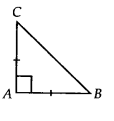 ⇒∠ACB = ∠ABC
Now, ∠A + ∠B + ∠C = 180° [Angle sum property of a ∆]
⇒90° + ∠B + ∠C = 180° [∠A = 90°(Given)]
⇒∠B + ∠C= 180°- 90° = 90°
But ∠B = ∠C
∠B = ∠C =
⇒∠ACB = ∠ABC
Now, ∠A + ∠B + ∠C = 180° [Angle sum property of a ∆]
⇒90° + ∠B + ∠C = 180° [∠A = 90°(Given)]
⇒∠B + ∠C= 180°- 90° = 90°
But ∠B = ∠C
∠B = ∠C =
 = 45°
Thus, ∠B = 45° and ∠C = 45°
Question 8. Show that the angles of an equilateral triangle are 60° each.
= 45°
Thus, ∠B = 45° and ∠C = 45°
Question 8. Show that the angles of an equilateral triangle are 60° each.
Solution:
In ∆ABC, we have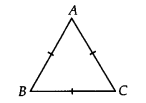 AB = BC = CA
[ABC is an equilateral triangle]
AB = BC
⇒∠A = ∠C …(1) [Angles opposite to equal sides of a A are equal]
Similarly, AC = BC
⇒∠A = ∠B …(2)
From (1) and (2), we have
∠A = ∠B = ∠C = x (say)
Since, ∠A + ∠B + ∠C = 180° [Angle sum property of a A]
∴x + x + x = 180o
⇒3x = 180°
⇒x = 60°
∴∠A = ∠B = ∠C = 60°
Thus, the angles of an equilateral triangle are 60° each.
AB = BC = CA
[ABC is an equilateral triangle]
AB = BC
⇒∠A = ∠C …(1) [Angles opposite to equal sides of a A are equal]
Similarly, AC = BC
⇒∠A = ∠B …(2)
From (1) and (2), we have
∠A = ∠B = ∠C = x (say)
Since, ∠A + ∠B + ∠C = 180° [Angle sum property of a A]
∴x + x + x = 180o
⇒3x = 180°
⇒x = 60°
∴∠A = ∠B = ∠C = 60°
Thus, the angles of an equilateral triangle are 60° each.
NCERT Solutions for Class 9 Maths Chapter 7 Exercise 7.3
Question 1. ABC and
ABC and
 DBC are two isosceles triangles on the same base BC and vertices A and D are on the same side of BC (See figure). If AD is extended to intersect BC at P, show that:
DBC are two isosceles triangles on the same base BC and vertices A and D are on the same side of BC (See figure). If AD is extended to intersect BC at P, show that:
 (i)
(i)
 ABD
ABD
 ACD
(ii)
ACD
(ii)
 ABP
ABP
 ACP
(iii) AP bisects
ACP
(iii) AP bisects
 A as well as
A as well as
 D.
(iv) AP is the perpendicular bisector of BC.
Solution:
(i)
D.
(iv) AP is the perpendicular bisector of BC.
Solution:
(i)
 ABC is an isosceles triangle.
ABC is an isosceles triangle.
 AB = AC
AB = AC
 DBC is an isosceles triangle.
DBC is an isosceles triangle.
 BD = CD
Now in
BD = CD
Now in
 ABD and
ABD and
 ACD,
AB = AC [Given]
BD = CD [Given]
AD = AD [Common]
ACD,
AB = AC [Given]
BD = CD [Given]
AD = AD [Common]

 ABD
ABD
 ACD [By SSS congruency]
ACD [By SSS congruency]

 BAD =
BAD =
 CAD [By C.P.C.T.] ……….(i)
(ii)Now in
CAD [By C.P.C.T.] ……….(i)
(ii)Now in
 ABP and
ABP and
 ACP,
AB = AC [Given]
ACP,
AB = AC [Given]
 BAD =
BAD =
 CAD [From eq. (i)]
AP = AP
CAD [From eq. (i)]
AP = AP

 ABP
ABP
 ACP [By SAS congruency]
(iii)Since
ACP [By SAS congruency]
(iii)Since
 ABP
ABP
 ACP [From part (ii)]
ACP [From part (ii)]

 BAP =
BAP =
 CAP [By C.P.C.T.]
CAP [By C.P.C.T.]
 AP bisects
AP bisects
 A.
Since
A.
Since
 ABD
ABD
 ACD [From part (i)]
ACD [From part (i)]

 ADB =
ADB =
 ADC [By C.P.C.T.] ……….(ii)
Now
ADC [By C.P.C.T.] ……….(ii)
Now
 ADB +
ADB +
 BDP =
BDP =
 [Linear pair] ……….(iii)
And
[Linear pair] ……….(iii)
And
 ADC +
ADC +
 CDP =
CDP =
 [Linear pair] ……….(iv)
From eq. (iii) and (iv),
[Linear pair] ……….(iv)
From eq. (iii) and (iv),
 ADB +
ADB +
 BDP =
BDP =
 ADC +
ADC +
 CDP
CDP

 ADB +
ADB +
 BDP =
BDP =
 ADB +
ADB +
 CDP [Using (ii)]
CDP [Using (ii)]

 BDP =
BDP =
 CDP
CDP
 DP bisects
DP bisects
 D or AP bisects
D or AP bisects
 D.
(iv)Since
D.
(iv)Since
 ABP
ABP
 ACP [From part (ii)]
ACP [From part (ii)]
 APB =
APB =
 APC [By C.P.C.T.] …….(vi)
Now
APC [By C.P.C.T.] …….(vi)
Now
 APB +
APB +
 APC =
APC =
 [Linear pair]
[Linear pair]

 APB +
APB +
 APC =
APC =
 [Using eq. (vi)]
[Using eq. (vi)]
 2
2
 APB =
APB =


 APB =
APB =

 AP
AP
 BC ……….(vii)
From eq. (v), we have BP PC and from (vii), we have proved AP
BC ……….(vii)
From eq. (v), we have BP PC and from (vii), we have proved AP
 B. So, collectively AP is perpendicular bisector of BC.
Question 2. AD is an altitude of an isosceles triangle ABC in which AB = AC. Show that:
(i) AD bisects BC.
(ii) AD bisects
B. So, collectively AP is perpendicular bisector of BC.
Question 2. AD is an altitude of an isosceles triangle ABC in which AB = AC. Show that:
(i) AD bisects BC.
(ii) AD bisects
 A.
Solution:
In
A.
Solution:
In
 ABD and
ABD and
 ACD,
AB = AC [Given]
ACD,
AB = AC [Given]
 ADB =
ADB =
 ADC =
ADC =

 [AD
[AD
 BC]
BC]
 AD = AD [Common]
AD = AD [Common]

 ABD
ABD
 ACD [RHS rule of congruency]
ACD [RHS rule of congruency]
 BD = DC [By C.P.C.T.]
BD = DC [By C.P.C.T.]
 AD bisects BC
Also
AD bisects BC
Also
 BAD =
BAD =
 CAD [By C.P.C.T.]
CAD [By C.P.C.T.]
 AD bisects
AD bisects
 A.
Question 3. Two sides AB and BC and median AM of one triangle ABC are respectively equal to sides PQ and OR and median PN of ∆PQR (see figure). Show that
(i) ∆ABC ≅∆PQR
(ii) ∆ABM ≅∆PQN
A.
Question 3. Two sides AB and BC and median AM of one triangle ABC are respectively equal to sides PQ and OR and median PN of ∆PQR (see figure). Show that
(i) ∆ABC ≅∆PQR
(ii) ∆ABM ≅∆PQN

Solution:
In ∆ABC, AM is the median. ∴BM = BC ……(1)
In ∆PQR, PN is the median.
∴QN =
BC ……(1)
In ∆PQR, PN is the median.
∴QN =
 QR …(2)
And BC = QR [Given]
⇒
QR …(2)
And BC = QR [Given]
⇒
 BC =
BC =
 QR
⇒BM = QN …(3) [From (1) and (2)]
(i) In ∆ABM and ∆PQN, we have
AB = PQ , [Given]
AM = PN [Given]
BM = QN [From (3)]
∴∆ABM ≅∆PQN [By SSS congruency]
(ii) Since ∆ABM ≅∆PQN
⇒∠B = ∠Q …(4) [By C.P.C.T.]
Now, in ∆ABC and ∆PQR, we have
∠B = ∠Q [From (4)]
AB = PQ [Given]
BC = QR [Given]
∴∆ABC ≅∆PQR [By SAS congruency]
Question 4. BE and CF are two equal altitudes of a triangle ABC. Using RHS congruence rule, prove that the triangle ABC is isosceles.
QR
⇒BM = QN …(3) [From (1) and (2)]
(i) In ∆ABM and ∆PQN, we have
AB = PQ , [Given]
AM = PN [Given]
BM = QN [From (3)]
∴∆ABM ≅∆PQN [By SSS congruency]
(ii) Since ∆ABM ≅∆PQN
⇒∠B = ∠Q …(4) [By C.P.C.T.]
Now, in ∆ABC and ∆PQR, we have
∠B = ∠Q [From (4)]
AB = PQ [Given]
BC = QR [Given]
∴∆ABC ≅∆PQR [By SAS congruency]
Question 4. BE and CF are two equal altitudes of a triangle ABC. Using RHS congruence rule, prove that the triangle ABC is isosceles.
Solution:
Since BE ⊥AC [Given] ∴BEC is a right triangle such that ∠BEC = 90°
Similarly, ∠CFB = 90°
Now, in right ∆BEC and ∆CFB, we have
BE = CF [Given]
BC = CB [Common hypotenuse]
∠BEC = ∠CFB [Each 90°]
∴∆BEC ≅∆CFB [By RHS congruency]
So, ∠BCE = ∠CBF [By C.P.C.T.]
or ∠BCA = ∠CBA
Now, in ∆ABC, ∠BCA = ∠CBA
⇒AB = AC [Sides opposite to equal angles of a ∆ are equal]
∴ABC is an isosceles triangle.
Question 5. ABC is an isosceles triangle with AB = AC. Draw AP ⊥BC to show that ∠B = ∠C.
Solution:
We have, AP ⊥BC [Given]
∴BEC is a right triangle such that ∠BEC = 90°
Similarly, ∠CFB = 90°
Now, in right ∆BEC and ∆CFB, we have
BE = CF [Given]
BC = CB [Common hypotenuse]
∠BEC = ∠CFB [Each 90°]
∴∆BEC ≅∆CFB [By RHS congruency]
So, ∠BCE = ∠CBF [By C.P.C.T.]
or ∠BCA = ∠CBA
Now, in ∆ABC, ∠BCA = ∠CBA
⇒AB = AC [Sides opposite to equal angles of a ∆ are equal]
∴ABC is an isosceles triangle.
Question 5. ABC is an isosceles triangle with AB = AC. Draw AP ⊥BC to show that ∠B = ∠C.
Solution:
We have, AP ⊥BC [Given]
 ∠APB = 90° and ∠APC = 90°
In ∆ABP and ∆ACP, we have
∠APB = ∠APC [Each 90°]
AB = AC [Given]
AP = AP [Common]
∴∆ABP ≅∆ACP [By RHS congruency]
So, ∠B = ∠C [By C.P.C.T.]
∠APB = 90° and ∠APC = 90°
In ∆ABP and ∆ACP, we have
∠APB = ∠APC [Each 90°]
AB = AC [Given]
AP = AP [Common]
∴∆ABP ≅∆ACP [By RHS congruency]
So, ∠B = ∠C [By C.P.C.T.]
NCERT Solutions for Class 9 Maths Chapter 7 Exercise 7.4
Question 1. Show that in a right angled triangle, the hypotenuse is the longest side.Solution:
Let us consider ∆ABC such that ∠B = 90° ∴∠A + ∠B + ∠C = 180° ⇒∠A + 90°-+ ∠C = 180° ⇒∠A + ∠C = 90° ⇒∠A + ∠C = ∠B ∴∠B > ∠A and ∠B > ∠C ⇒Side opposite to ∠B is longer than the side opposite to ∠A
i.e., AC > BC.
Similarly, AC > AB.
Therefore, we get AC is the longest side. But AC is the hypotenuse of the triangle. Thus, the hypotenuse is the longest side.
Question 2. In figure, sides AB and AC of ∆ABC are extended to points P and Q respectively. Also, ∠PBC < ∠QCB. Show that AC > AB.
⇒Side opposite to ∠B is longer than the side opposite to ∠A
i.e., AC > BC.
Similarly, AC > AB.
Therefore, we get AC is the longest side. But AC is the hypotenuse of the triangle. Thus, the hypotenuse is the longest side.
Question 2. In figure, sides AB and AC of ∆ABC are extended to points P and Q respectively. Also, ∠PBC < ∠QCB. Show that AC > AB.
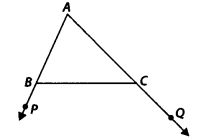
Solution:
∠ABC + ∠PBC = 180° [Linear pair] and ∠ACB + ∠QCB = 180° [Linear pair] But ∠PBC < ∠QCB [Given] ⇒180° – ∠PBC > 180° – ∠QCB ⇒∠ABC > ∠ACB The side opposite to ∠ABC > the side opposite to ∠ACB ⇒AC > AB. Question 3. In figure, ∠B <∠A and ∠C <∠D. Show that AD < BC.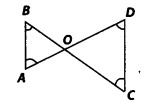
Solution:
Since ∠A > ∠B [Given] ∴OB > OA …(1) [Side opposite to greater angle is longer] Similarly, OC > OD …(2) Adding (1) and (2), we have OB + OC > OA + OD ⇒BC > AD Question 4. AB and CD are respectively the smallest and longest sides of a quadrilateral ABCD (see figure). Show that ∠A > ∠C and ∠B >∠D.
Solution:
Let us join AC.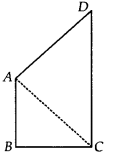 Now, in ∆ABC, AB < BC [∵AB is the smallest side of the quadrilateral ABCD] ⇒BC > AB
⇒∠BAC > ∠BCA …(1)
[Angle opposite to longer side of A is greater]
Again, in ∆ACD, CD > AD
[ CD is the longest side of the quadrilateral ABCD]
⇒∠CAD > ∠ACD …(2)
[Angle opposite to longer side of ∆ is greater]
Adding (1) and (2), we get
∠BAC + ∠CAD > ∠BCA + ∠ACD
⇒∠A > ∠C
Similarly, by joining BD, we have ∠B > ∠D.
Now, in ∆ABC, AB < BC [∵AB is the smallest side of the quadrilateral ABCD] ⇒BC > AB
⇒∠BAC > ∠BCA …(1)
[Angle opposite to longer side of A is greater]
Again, in ∆ACD, CD > AD
[ CD is the longest side of the quadrilateral ABCD]
⇒∠CAD > ∠ACD …(2)
[Angle opposite to longer side of ∆ is greater]
Adding (1) and (2), we get
∠BAC + ∠CAD > ∠BCA + ∠ACD
⇒∠A > ∠C
Similarly, by joining BD, we have ∠B > ∠D.
Question 5. In figure, PR > PQ and PS bisect ∠QPR. Prove that ∠PSR >∠PSQ.
 Solution:
In ∆PQR, PS bisects ∠QPR [Given]
∴∠QPS = ∠RPS
and PR > PQ [Given]
⇒∠PQS > ∠PRS [Angle opposite to longer side of A is greater]
⇒∠PQS + ∠QPS > ∠PRS + ∠RPS …(1) [∵∠QPS = ∠RPS]
∵Exterior ∠PSR = [∠PQS + ∠QPS]
and exterior ∠PSQ = [∠PRS + ∠RPS]
[An exterior angle is equal to the sum of interior opposite angles]
Now, from (1), we have
∠PSR = ∠PSQ.
Question 6. Show that of all line segments drawn from a given point not on it, the perpendicular line segment is the shortest.
Solution:
In ∆PQR, PS bisects ∠QPR [Given]
∴∠QPS = ∠RPS
and PR > PQ [Given]
⇒∠PQS > ∠PRS [Angle opposite to longer side of A is greater]
⇒∠PQS + ∠QPS > ∠PRS + ∠RPS …(1) [∵∠QPS = ∠RPS]
∵Exterior ∠PSR = [∠PQS + ∠QPS]
and exterior ∠PSQ = [∠PRS + ∠RPS]
[An exterior angle is equal to the sum of interior opposite angles]
Now, from (1), we have
∠PSR = ∠PSQ.
Question 6. Show that of all line segments drawn from a given point not on it, the perpendicular line segment is the shortest.
Solution:
Let us consider the ∆PMN such that ∠M = 90° Since, ∠M + ∠N+ ∠P = 180°
[Sum of angles of a triangle is 180°]
∵∠M = 90° [PM ⊥l]
So, ∠N + ∠P = ∠M
⇒∠N < ∠M
⇒PM < PN …(1)
Similarly, PM < PN1…(2)
and PM < PN2…(3)
From (1), (2) and (3), we have PM is the smallest line segment drawn from P on the line l. Thus, the perpendicular line segment is the shortest line segment drawn on a line from a point not on it.
Since, ∠M + ∠N+ ∠P = 180°
[Sum of angles of a triangle is 180°]
∵∠M = 90° [PM ⊥l]
So, ∠N + ∠P = ∠M
⇒∠N < ∠M
⇒PM < PN …(1)
Similarly, PM < PN1…(2)
and PM < PN2…(3)
From (1), (2) and (3), we have PM is the smallest line segment drawn from P on the line l. Thus, the perpendicular line segment is the shortest line segment drawn on a line from a point not on it.
NCERT Solutions for Class 9 Maths Chapter 7 Exercise 7.5
Question 1. ABC is a triangle. Locate a point in the interior of ∆ ABC which is equidistant from all the vertices of ∆ ABC.Solution:
Let us consider a ∆ABC. Draw l, the perpendicular bisector of AB. Draw m, the perpendicular bisector of BC. Let the two perpendicular bisectors l and m meet at O. O is the required point which is equidistant from A, B and C. Note: If we draw a circle with centre O and radius OB or OC, then it will pass through A, B and C. The point O is called circumcentre of the triangle.
Question 2. In a triangle locate a point in its interior which is equidistant from all the sides of the triangle.
Note: If we draw a circle with centre O and radius OB or OC, then it will pass through A, B and C. The point O is called circumcentre of the triangle.
Question 2. In a triangle locate a point in its interior which is equidistant from all the sides of the triangle.
Solution:
Let us consider a ∆ABC. Draw m, the bisector of ∠C.
Let the two bisectors l and m meet at O.
Thus, O is the required point which is equidistant from the sides of ∆ABC.
Note: If we draw OM ⊥BC and draw a circle with O as centre and OM as radius, then the circle will touch the sides of the triangle. Point O is called incentre of the triangle.
Draw m, the bisector of ∠C.
Let the two bisectors l and m meet at O.
Thus, O is the required point which is equidistant from the sides of ∆ABC.
Note: If we draw OM ⊥BC and draw a circle with O as centre and OM as radius, then the circle will touch the sides of the triangle. Point O is called incentre of the triangle.
 Question 3. In a huge park, people are concentrated at three points (see figure)
Question 3. In a huge park, people are concentrated at three points (see figure)
 A: where these are different slides and swings for children.
B: near which a man-made lake is situated.
C: which is near to a large parking and exist.
Where should an ice-cream parlor be set? up so that maximum number of persons can approach it?
[Hint The parlour should be equidistant from A, B and C.]
A: where these are different slides and swings for children.
B: near which a man-made lake is situated.
C: which is near to a large parking and exist.
Where should an ice-cream parlor be set? up so that maximum number of persons can approach it?
[Hint The parlour should be equidistant from A, B and C.]
Solution:
Let us join A and B, and draw l, the perpendicular bisector of AB. Now, join B and C, and draw m, the perpendicular bisector of BC. Let the perpendicular bisectors l and m meet at O. The point O is the required point where the ice cream parlour be set up. Note: If we join A and C and draw the perpendicular bisector, then it will also meet (or pass through) the point O. Question 4. Complete the hexagonal and star shaped Rangolies [see Fig. (i) and (ii)] by filling them with as many equilateral triangles of side 1 cm as you can. Count the number of triangles in each case. Which has more triangles?
Question 4. Complete the hexagonal and star shaped Rangolies [see Fig. (i) and (ii)] by filling them with as many equilateral triangles of side 1 cm as you can. Count the number of triangles in each case. Which has more triangles?

Solution:
It is an activity. We require 150 equilateral triangles of side 1 cm in the Fig. (i) and 300 equilateral triangles in the Fig. (ii). ∴The Fig. (ii) has more triangles.Benefits of NCERT Solutions for Class 9 Maths Chapter 7
The NCERT Solutions for Class 9 Maths Chapter 7, "Triangles," offer several benefits that aid students in mastering the concepts of geometry:Comprehensive Understanding : The solutions provide detailed explanations of concepts such as congruence, triangle inequalities, and angle properties, ensuring students have a solid grasp of the material.
Step-by-Step Guidance : Each problem is solved methodically, allowing students to follow the logic and reasoning behind each step, which helps in developing problem-solving skills.
Conceptual Clarity : By breaking down complex problems into manageable steps, the solutions enhance students' understanding of geometric principles and their applications.
Exam Preparation : The solutions align with the NCERT syllabus and exam pattern, helping students prepare effectively for school exams and competitive tests.
Practice Opportunities : With a variety of problems to solve, students can practice extensively, reinforcing their learning and building confidence.
NCERT Solutions for Class 9 Maths Chapter 7 FAQs
Which is hardest chapter in maths class 9?
Which is the easiest chapter in NCERT Maths Class 9?
What is the full concept of a triangle?
Who invented the triangle?












